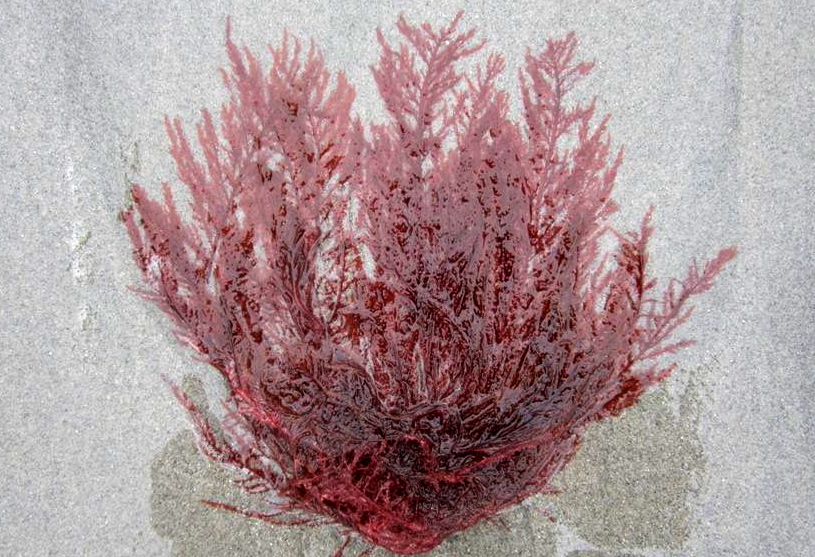Sea fern, red fan • Neoptilota asplenioides
Identification
This red alga has a fern-like branching structure and ranges from dark red to bright pinkish-red. It has many orders of branching composed of opposite branch pairs. The pairs in the last order of branching are uneven, with one branch lengthening and maturing into a reproductive structure over time, while the other branch remains short. The margins of the end branches are toothed. Sea fern has a disc-shaped holdfast and gets to 40 cm tall.
Habitat & Range
Sea fern grows on both rock and other seaweeds from the low intertidal to the shallow subtidal. It most commonly grows in exposed and semi-exposed locations. Its range stretches from northern Washington north to the Bering Sea and Aleutian Islands; it is also found along coastlines of Siberia and Japan.
Similar Species
Neoptilota hypnoides is a similar fern-like red alga. Its end branches lack the serrated edges of N. asplenioides. Other similar species are Ptilota sp., P. serrata, N. densa, and N. californica.
iNaturalist
https://www.inaturalist.org/taxa/502559-Neoptilota-asplenioides
This red alga has a fern-like branching structure and ranges from dark red to bright pinkish-red. It has many orders of branching composed of opposite branch pairs. The pairs in the last order of branching are uneven, with one branch lengthening and maturing into a reproductive structure over time, while the other branch remains short. The margins of the end branches are toothed. Sea fern has a disc-shaped holdfast and gets to 40 cm tall.
Habitat & Range
Sea fern grows on both rock and other seaweeds from the low intertidal to the shallow subtidal. It most commonly grows in exposed and semi-exposed locations. Its range stretches from northern Washington north to the Bering Sea and Aleutian Islands; it is also found along coastlines of Siberia and Japan.
Similar Species
Neoptilota hypnoides is a similar fern-like red alga. Its end branches lack the serrated edges of N. asplenioides. Other similar species are Ptilota sp., P. serrata, N. densa, and N. californica.
iNaturalist
https://www.inaturalist.org/taxa/502559-Neoptilota-asplenioides
References
Lamb, A., and Hanby, B. (2005). Marine Life of the Pacific Northwest [electronic version]. Madeira Park, BC: Harbour Publishing.
Lindberg, M. and Lindstrom, S. (2010). Neoptilota asplenioides. Seaweeds of Alaska. Accessed 23/01/2015.
O'Clair, R. and Lindstrom, S. Neoptilota asplenioides (Esper) Kylin. In Klinkenberg, Brian. (Ed.). E-Flora BC: Electronic Atlas of the Plants of British Columbia. Lab for Advanced Spatial Analysis, Department of Geography, University of British Columbia, Vancouver. Accessed 23/01/2015.
Authors and editors of page
Kelly Fretwell and Brian Starzomski (2015).
Lamb, A., and Hanby, B. (2005). Marine Life of the Pacific Northwest [electronic version]. Madeira Park, BC: Harbour Publishing.
Lindberg, M. and Lindstrom, S. (2010). Neoptilota asplenioides. Seaweeds of Alaska. Accessed 23/01/2015.
O'Clair, R. and Lindstrom, S. Neoptilota asplenioides (Esper) Kylin. In Klinkenberg, Brian. (Ed.). E-Flora BC: Electronic Atlas of the Plants of British Columbia. Lab for Advanced Spatial Analysis, Department of Geography, University of British Columbia, Vancouver. Accessed 23/01/2015.
Authors and editors of page
Kelly Fretwell and Brian Starzomski (2015).





